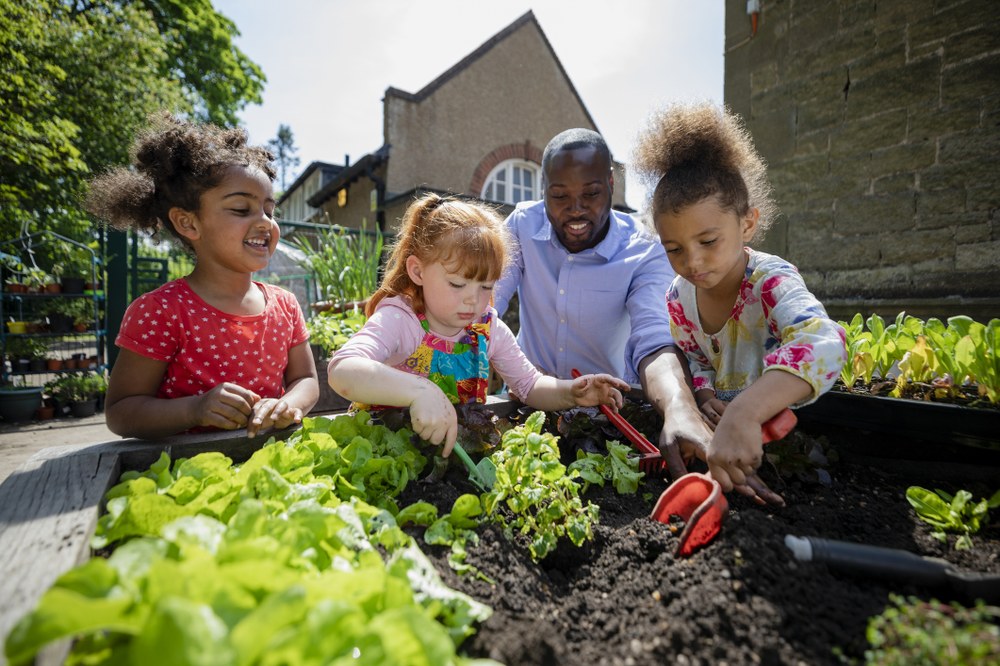Posted: May 12, 2025
Educators and families can gently guide children to develop a love for nature and begin to understand how to care for and protect the natural world.

Adult with young children working in a garden outside
Jennifer Hooven, childhood education coordinator at The Arboretum at Penn State, states that: "When children are supported to engage with nature, they discover its marvels and mysteries as well as their own interconnectedness. Engaging a whole family in this way is even more meaningful because research shows that when children spend time in nature with a trusted adult, they are more likely to grow into ecological citizens who value and protect our natural resources" (Penn State Outreach, 2023, para. 4).
Green muscle memory (Coon, Dennis, & Walker, n.d.) refers to learning about and repeating actions that support environmental and ecological behaviors and habits. These natural actions become part of children's automatic behaviors and practices, or green muscle memory. For example, young children build green muscle memory when they use repetitive, daily practices like watering plants and being responsible for filling, storing, and keeping track of reusable water bottles. It's like learning to ride a bike or tie shoes—you don't forget how!
Emphasize the Head, Heart, and Hands
Transformative education is a holistic approach involving the head (knowledge), heart (affective), and hands (action) (Olsen et al., 2024). Emphasizing the head, heart, and hands approach is used in various educational methods to leverage thoughtful discussions, critical thinking (head), physical actions (hands), and experiencing connection (heart).
The concept of using head, heart, and hands is instrumental in fostering green muscle memory and care for nature. For example, spending regular time in nature with attentive and caring adults (heart) helps children thrive and become budding earth stewards. Children learn (head) that their green muscle memory actions (hands) make a transformative impact in caring for nature. When children learn about practices such as recycling and composting—routines that repeat daily and across social settings (home, school, community spaces, etc.)—green muscle memory practices and actions become second nature.
Think about how you can use the frame of "head, heart, and hands" and green muscle memory to offer regular opportunities for children to interact and connect with nature and collectively practice actions like caring for worms in the compost garden, which inspires a profound curiosity for composting (head), feeding the worms (hands), and tending to the worm's life cycle (heart).
Love and Care for Nature: Build Green Muscle Memory, Emphasizing the Head, Heart, and Hands
Head (thinking)
- Book it: Read books based on children's interests in nature and caring for the earth. Try the Blueberry Awards, chosen to strengthen children's connections with nature and foster action for the planet.
- Group chat: Engage in social discussions about caring for nature. Ask, "What IS nature?" "What IS NOT nature?" "Where do you like to go to find nature?" "What do you like about being outside?" "What can we do together in nature?" "What can we do together to take care of nature?" Connect with groups like the Children & Nature Network and the Natural Start Alliance to learn ways to engage children with nature.
Heart (feeling)
- Wheel of emotions: Invite children to use feeling wheels to identify emotions about nature and caring for nature (and one another!). Try the "Feeling Faces Wheel" from the National Center for Pyramid Model Innovations.
- Grow love: Care for living things, such as growing native seeds and plants to attract and care for butterflies and moths. Learn more about plants from The National Play Value Plant Database and the Natural Learning Initiative.
Hands (doing)
- Nature mapping: Collaborate with children, families, and peers to curate a list, drawings, and map of favorite local nature spots and why they are unique. Try Nature Memory Mapping from the Natural History Museum of LA County.
- Green hour: Host a family green hour or sustainability hour. Invite families and community members to share sustainability practices and ways to discover nature. Explore the National Wildlife Federation GREENHOUR ™ for nature activities.
References
Coon, B., Nolasco, D., & Walker, E. (n.d.). Climate Education vs the Climate Crisis (PDF). EARTHDAY.org.
Olsen, E. K., Lawson, D. F., McClain, L. R., & Plummer, J. D. (2024). Heads, hearts, and hands: a systematic review of empirical studies about eco/climate anxiety and environmental education. Environmental Education Research, 30(12), 2131–2158.
Penn State Outreach. (2023). Women Making an Impact: Jennifer Hooven.

